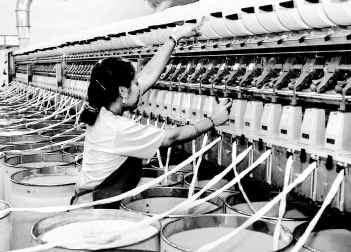Warehouse Management Systems: Making Warehouses Small Enough for Management
Warehouse Management Systems: Making Warehouses Small Enough for Management
 Big, spacious, and vital these three words are some in a laundry list of adjectives that properly describes a warehouse. Every product that comes from an adjacent town, a neighboring state, or from across the ocean first lands on this gargantuan storage facility. From there, warehouse staff coordinates the flow of goods to be distributed to retail stores and other establishments.
Big, spacious, and vital these three words are some in a laundry list of adjectives that properly describes a warehouse. Every product that comes from an adjacent town, a neighboring state, or from across the ocean first lands on this gargantuan storage facility. From there, warehouse staff coordinates the flow of goods to be distributed to retail stores and other establishments.
Modern warehouses rarely use pen and paper to accomplish inventory tasks. Instead, they have sophisticated management system software that lets them cover more ground while allowing for close monitoring of the flow of goods. Considering their size, if it takes wheels to carry goods in and out of the warehouse, it also takes wheels to go around. Walking from one end of the warehouse to the other end wastes precious time and energy for the workers.
An integrated system of computers and scanning machines keep track of what is in storage, what is being moved, what has to move and what needs to arrive. The system does the work of roughly the entire warehouse staff taking inventory of endless rows of goods, finishing the job in less time. Warehouse management systems account for a significant portion of potential profit for the retail establishments as well as the warehouse itself. To put it figuratively, it makes the warehouse small.
Moving goods in large quantities may prove to be a challenge without warehouse management systems helping workers. Even if such systems are designed to reduce labor costs, the human factor is still a significant element of warehouse management. Goods will not scan and register by themselves, as warehouse workers have to do such tasks with portable scanners. The code for each marked item is sent to the computer for indexing and monitoring.
Warehouse software for goods management also has another benefit: ensuring that the orders are correct. Since there can be no room for error when deliveries need to be made, the system helps workers in locating the correct item for shipping. The system significantly lowers human error in distribution of goods, equivalent to more profit. With warehouse software, the tomatoes a retail store orders will not end up as potatoes.
It is possible for a huge facility to be managed by small but powerful warehouse management systems. When deliveries grow hectic, trust this innovative system to make every delivery fast and right at the same time. In the future, warehouses will still be the drop-off points for more goods. Fortunately, warehouse management software can still get the job done no matter how much it needs to work.…

 Many homes these days still use home heating oil to keep their houses warm in the wintertime, as well as to heat the water in their hot water tank or for their washer and dishwasher. As everyone has probably noticed, anything that is made of an oil product has been going up in price on almost a daily basis.
Many homes these days still use home heating oil to keep their houses warm in the wintertime, as well as to heat the water in their hot water tank or for their washer and dishwasher. As everyone has probably noticed, anything that is made of an oil product has been going up in price on almost a daily basis. It’s not a big secret, from the common man to the business industry that the recession has hurt them all. Through those lean times, companies of all sizes found that they were making changes, scaling back and even losing well more than anticipated. When the economy moves to a slump it hurts, from the smallest to the largest, with everyone else being caught in between. Now they say that when the bottom is hit there is only one way to travel and that is up. As the economy begins to show signs of growth and life, companies are finding that their phones are ringing, orders are coming in and profits are beginning to once again come through. Along with this, comes another change! For those looking to roll with the change, improve their competitive edge and even take their company to the next level they should really look at their warehouse operations! Yes, that’s right, the warehouse processes. Here’s a little more about why:
It’s not a big secret, from the common man to the business industry that the recession has hurt them all. Through those lean times, companies of all sizes found that they were making changes, scaling back and even losing well more than anticipated. When the economy moves to a slump it hurts, from the smallest to the largest, with everyone else being caught in between. Now they say that when the bottom is hit there is only one way to travel and that is up. As the economy begins to show signs of growth and life, companies are finding that their phones are ringing, orders are coming in and profits are beginning to once again come through. Along with this, comes another change! For those looking to roll with the change, improve their competitive edge and even take their company to the next level they should really look at their warehouse operations! Yes, that’s right, the warehouse processes. Here’s a little more about why: Whether you are involved in manufacturing, shipping, or just handle any kind of large volume, you are always looking for ways to make your processing more efficient. After all, greater efficiency means more volume in less time, which means more overall profits. One way to help reduce waste and improve the overall performance of your facilities is by improving current material handling systems, replacing warehouse management systems, or installing new automated conveyor systems if none are in use. How do you know if your setup might be made more efficient? Follow these tips and find out.
Whether you are involved in manufacturing, shipping, or just handle any kind of large volume, you are always looking for ways to make your processing more efficient. After all, greater efficiency means more volume in less time, which means more overall profits. One way to help reduce waste and improve the overall performance of your facilities is by improving current material handling systems, replacing warehouse management systems, or installing new automated conveyor systems if none are in use. How do you know if your setup might be made more efficient? Follow these tips and find out. Biofuels are a leading source of renewable energy, particularly as transportation fuels that would replace oil-derived gasoline and diesel. But when you think about it, oil deposits are derived from biomass that has decomposed and been compressed underneath the surface of the earth for millennia.A� Given that the origin of petroleum is biological, why isn’t oil considered a biofuel? What is the distinction between petroleum and, for example, ethanol or biodiesel? And just what exactly is a biofuel anyway?
Biofuels are a leading source of renewable energy, particularly as transportation fuels that would replace oil-derived gasoline and diesel. But when you think about it, oil deposits are derived from biomass that has decomposed and been compressed underneath the surface of the earth for millennia.A� Given that the origin of petroleum is biological, why isn’t oil considered a biofuel? What is the distinction between petroleum and, for example, ethanol or biodiesel? And just what exactly is a biofuel anyway? Most of the warehouses in Europe have been on the move of employing new and technology-oriented mechanisms in an attempt to improve their warehouse management system. Before we go any further, one ought to know that the only way to get warehouse supply chains to improve is by employing acceptable and manageable warehouse management systems. As a large corporation, you need to appreciate each and every detail that will add value to your service delivery. Therefore, as a well-developed warehousing firm with the aim of gaining popularity in Britain and other parts of the European continent, I suggest that you employ the following.
Most of the warehouses in Europe have been on the move of employing new and technology-oriented mechanisms in an attempt to improve their warehouse management system. Before we go any further, one ought to know that the only way to get warehouse supply chains to improve is by employing acceptable and manageable warehouse management systems. As a large corporation, you need to appreciate each and every detail that will add value to your service delivery. Therefore, as a well-developed warehousing firm with the aim of gaining popularity in Britain and other parts of the European continent, I suggest that you employ the following. With the main UK political parties wanting to create thousands of new green jobs over the next ten years it will be interesting to see how we aim to become a market leader in green technology which is where China are currently the world leader. India is aiming to be a solar country within 10 years as it deals with decreasing fossil fuels and population growth that is gulping petrol and oil at an unprecedented rate.
With the main UK political parties wanting to create thousands of new green jobs over the next ten years it will be interesting to see how we aim to become a market leader in green technology which is where China are currently the world leader. India is aiming to be a solar country within 10 years as it deals with decreasing fossil fuels and population growth that is gulping petrol and oil at an unprecedented rate.